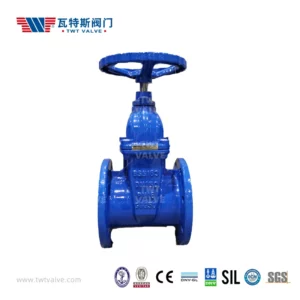DIN 3202 F4 & F5 are standard designations for gate valves defined by the Deutsches Institut für Normung (DIN) in Germany. These gate valves are widely used in various industries and applications. By understanding their applications and implementing best practices, you can maximize efficiency and performance. Here’s a guide to decoding the applications of DIN 3202 F4 and F5 gate valves:
Water Supply and Distribution:
DIN 3202 F4 and F5 gate valves are commonly used in water supply and distribution systems. They provide effective shut-off and control of water flow in pipelines, reservoirs, treatment plants, pumping stations, and water distribution networks. These valves are suitable for handling clean water, potable water, and non-aggressive liquids.
Sewage and Wastewater Systems:
Gate valves are also utilized in sewage and wastewater systems. DIN 3202 F4 and F5 gate valves can handle the flow of sewage, wastewater, sludge, and other fluids with solid particles. They are commonly installed in wastewater treatment plants, sewer lines, pumping stations, and industrial wastewater management systems.
Irrigation Systems:
Gate valves are essential components in irrigation systems for agricultural and landscaping purposes. DIN 3202 F4 and F5 gate valves regulate the flow of water to irrigation pipes, sprinkler systems, and drip irrigation systems. They provide reliable shut-off and precise control to ensure efficient water distribution for irrigation purposes.
Oil and Gas Industry:
While DIN 3202 F4 and F5 gate valves are primarily designed for water applications, they can also be used in certain low-pressure and non-critical oil and gas applications. These valves may find use in oil and gas pipelines, storage facilities, and refineries, where the operational conditions are within the valve’s specified limits.
Chemical and Process Industry:
DIN 3202 F4 and F5 gate valves can be employed in the chemical and process industry for handling non-aggressive fluids. They are suitable for applications where isolation, shut-off, or control of flow is required. These valves may be utilized in chemical plants, petrochemical facilities, pharmaceutical manufacturing, and other similar industrial processes.
Best Practices to Maximize Efficiency and Performance:
Proper Sizing and Selection:
Ensure that the DIN 3202 F4 and F5 gate valves are correctly sized for the intended application. Consider factors such as flow rate, pressure, temperature, fluid characteristics, and the system’s requirements. Oversized or undersized valves can result in inefficiencies, increased pressure drop, and poor performance.
Material Selection:
Select gate valves constructed from materials compatible with the fluid being handled and the operating conditions. Consider factors such as fluid corrosiveness, temperature, pressure, and the presence of abrasive particles. Choose materials that offer resistance to corrosion, erosion, and chemical attack to ensure long-term reliability.
Proper Installation:
Follow the manufacturer’s guidelines for proper valve installation. Ensure correct alignment, torque specifications for bolting, and appropriate gasket selection. Proper installation prevents leaks, ensures smooth operation, and promotes optimal performance. Valves should be installed in the correct orientation and properly supported to avoid stress on the valve body and associated piping.

Regular Maintenance and Inspection:
Implement a proactive maintenance program for DIN 3202 F4 and F5 gate valves. Schedule regular inspections, cleaning, and lubrication of valve components. Monitor the condition of seals, gaskets, and stem packing, and replace them as needed. Follow manufacturer recommendations for maintenance intervals and procedures.
Actuation and Operation:
Gate valves can be operated manually or with the assistance of actuators. Ensure that the actuation mechanism is suitable for the application and that it operates smoothly and reliably. Train operators on proper valve operation and maintenance procedures to maximize efficiency and minimize the risk of damage.
Monitoring and Performance Evaluation:
Regularly monitor the performance of DIN 3202 F4 and F5 gate valves. Assess their sealing capability, throttling accuracy, and response time. Conduct periodic tests, such as seat leakage tests and pressure tests, to verify the valve’s integrity. Evaluate the performance data and compare it against expected results to identify any deviations or potential issues.
By understanding the applications of DIN 3202 F4 and F5 gate valves and implementing best practices, you can maximize their efficiency and performance. These valves are reliable and versatile components widely used in water supply, wastewater management, irrigation, and certain low-pressure oil and gas applications. Adhering to best practices ensures their optimal operation and longevity.